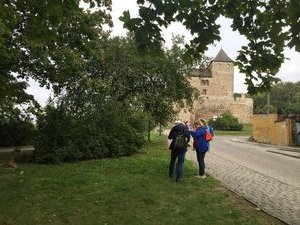Advertisement
Published: September 28th 2016

 The Medieval Castle
The Medieval Castle
On the greenery was located the original Jewish shtetl under the nose of the castle. In the Talmud we read about the belief that in every generation there exist 36 righteous human beings who are unknown to each other and are also unaware of their own special role in the world. They are simple and humble and anonymous individuals who behave in such a humane way that they justify the reason for the continued existence of humanity. In Hebrew they are called both Lamed Vavnivks- based on the Hebrew letter lamed that equals 30 and the letter vav that equals six, and Tsadikim Nistarim - the hidden righteous.
Today many of us felt we had met one of those in our generation. His name is Piotr. He's a Pole in his thirties who was born and lives in the city of Bedzin also known as Bendin in Yiddish. It's located in southern Poland in what was once a highly industrial zone not far from Prussia, near Silesia. A very old city with a medieval castle and a Jewish community that was established early and grew in importance over the several hundred years of its existence. For those of you who have read Maus, it's only two miles from the town where Art Speigelman's family lived.

 Bedzin
Bedzin
A photograph and description of the Jewish quarter before the Nazi destruction. In this spot Jews showed the capacity to invent and reinvent themselves and their contribution to the life of this region. Many Hasidim lived in the city and were very involved in its commercial flourishing in the interwar period. There were eight small Hasidic prayer houses scattered in the city center (called shtiebels). Poor people lived next door to the middle class and the wealthy. When the Nazis invaded this city it was one of the first Polish centers attacked in a vicious pogrom on the first Shabbat of the war. Its large synagogue was burned to the ground with Jews locked inside - they thought they would be safer in the synagogue. Before the war there were around 30,000 Jews out of a population of 60,000. Today there are three.
But let me get back to Piotr. At some point he and his wife began to explore the history of the city's Jews. They realized that all memory in this city of a big part of its past was quickly disappearing. And so they asked the mayor of the town if he would help to research ways to commemorate and educate. The mayor wasn't interested. But Piotr and

 Site of the City Synagogue
Site of the City Synagogue
The only indication of a grand building. his wife persevered with the help of a few of the descendants of some of Belzin's Jews. In time they excavated the past. They discovered one of the prayerhouses, personally rented it from the current landlord and then peeled away the layers of cheap paint and recreated it as a tiny museum and educational center with the feel of the past. Plaques in the city center discreetly tell a story about the place. A monument on the site of the ghetto now exists.
As we listened to Piotr, someone asked him why he cares about the Jews of Bedzin. An unassuming but clearly deep thinking person he shared with us that the city- his city - has a full and complex story and the Jews were part of it. Crucial to it. There are no Jews to do the work of sustaining that story and yet he felt it was necessary to flesh out the past and to educate those who care. But he added as well that as a Pole he thinks about what is and will be Polish identity. That Poland is one of the most homegenous countries today in Europe is not a good thing for

 Street view
Street view
One of the side street off the market square where Jews lived. Poland to his way of imagining identity; with growing extreme nationalism in Europe he wants to affirm that once Poland had a state filled with different national and ethnic groups and different religions and it flourished eve with tensions and struggles. That past should not be buried but rather understood as part of the ongoing quest to create a national identity that is open and pluralistic rather than turned inward and exclusionary.
We all felt the depth of Piotr's complex commitment to a flourishing human family that passes through the local history of Poland and its Jews. A Lamed Vavnick.
Before leaving the shtiebel we prayed the afternoon prayer together. There are three Orthodox Jewish men from Israel on the trip but we all- women, men, secular, religious, Jew, Christian gathered in the tiny space that until 1939 was a place brimming with life of devout Jews. Perhaps it was the first time that the prayer for peace that concludes every Jewish liturgy had been uttered since the war.
Advertisement
Tot: 0.077s; Tpl: 0.015s; cc: 12; qc: 27; dbt: 0.0314s; 1; m:domysql w:travelblog (10.17.0.13); sld: 2;
; mem: 1.1mb














Shannon Kelly
non-member comment
Miss you but feel as if I'm right alongside you thru your incredible trip. xxxooo